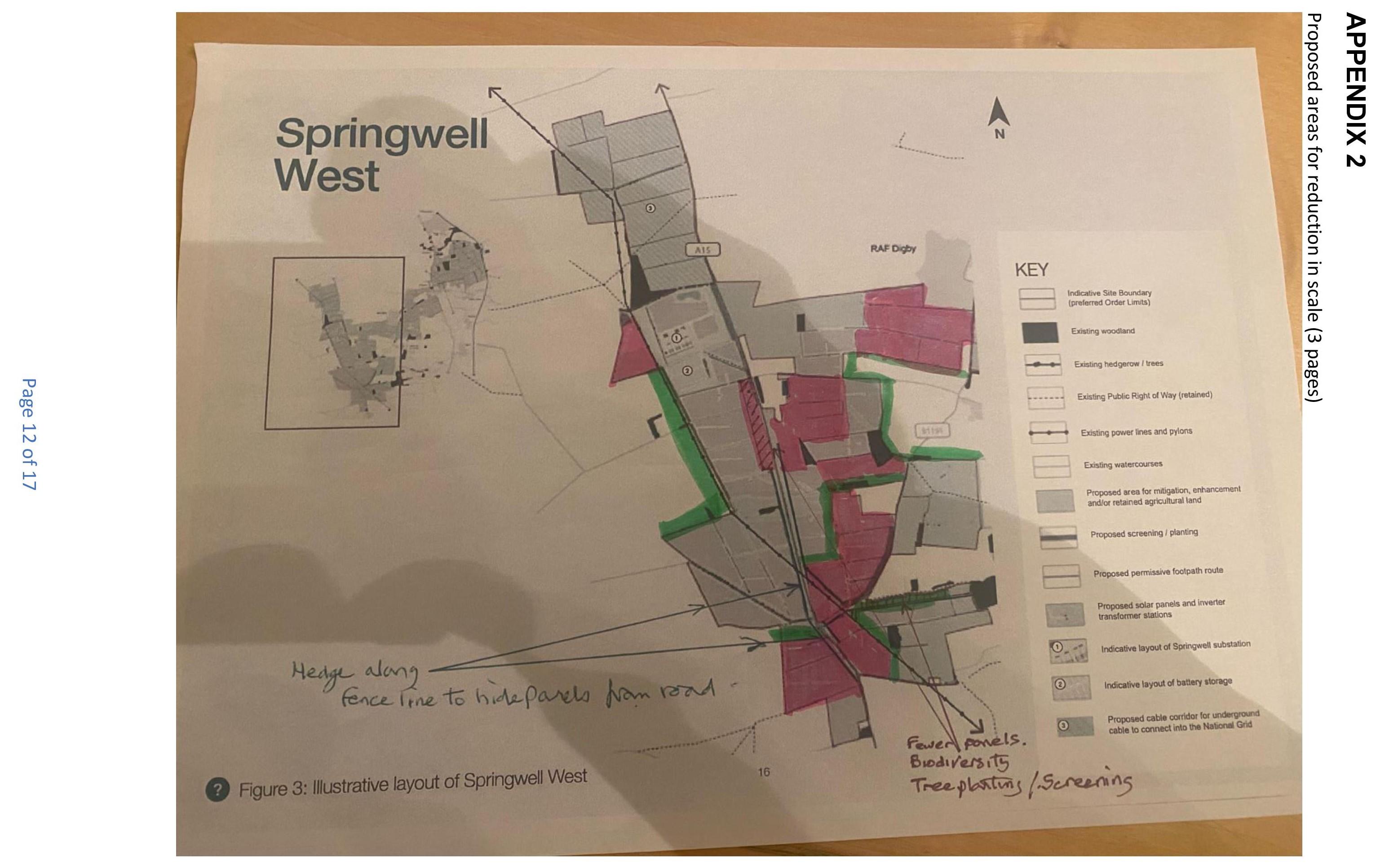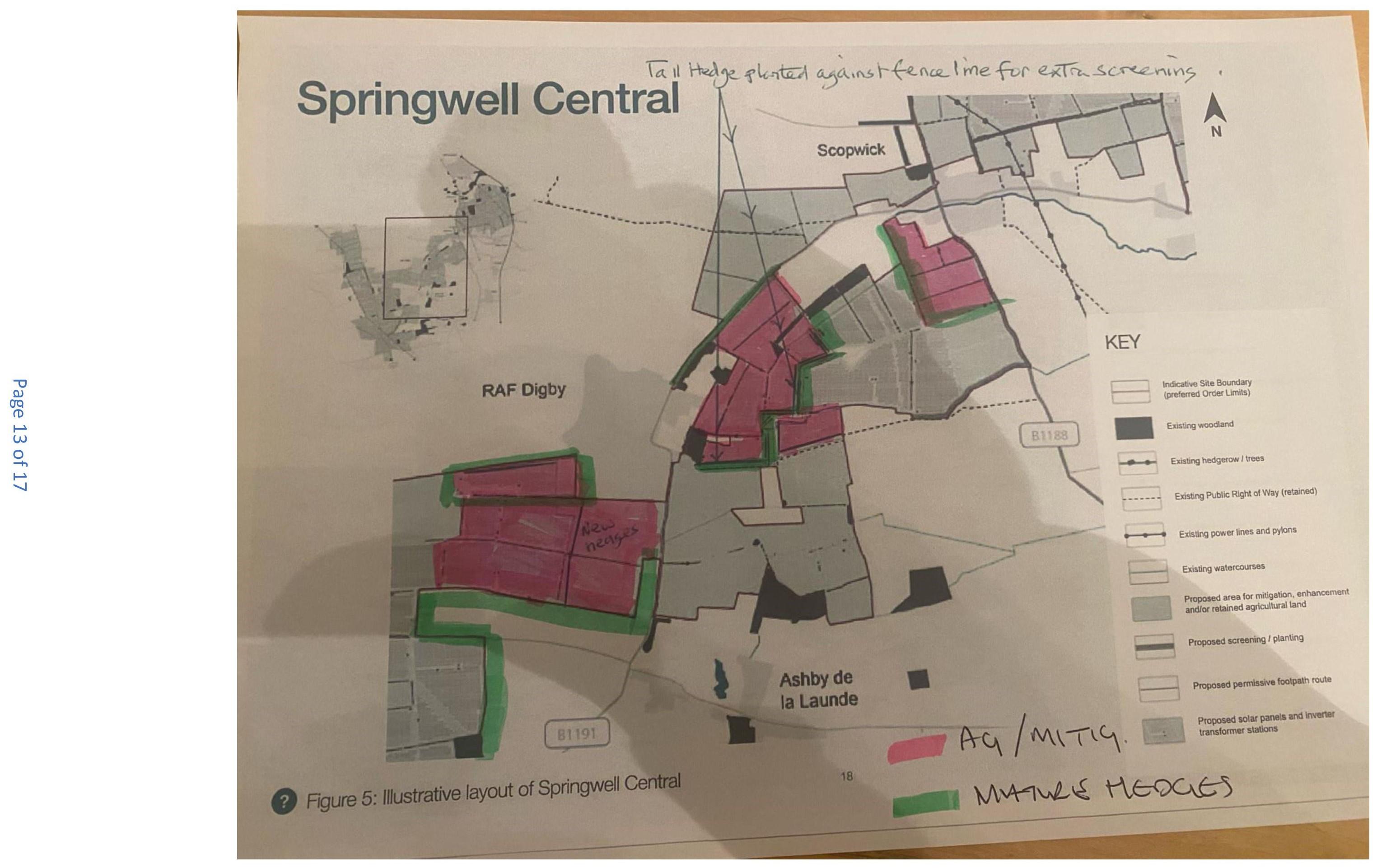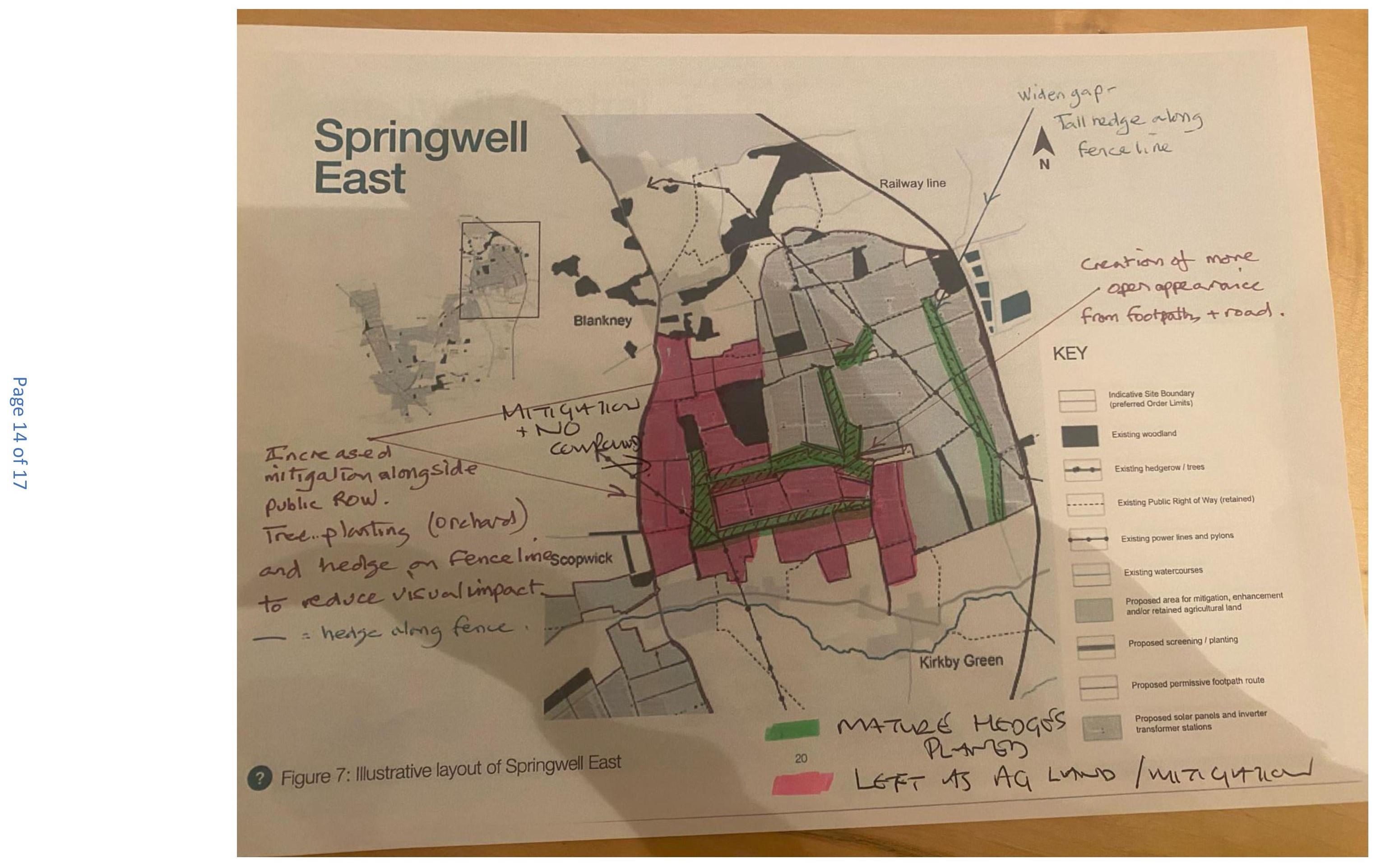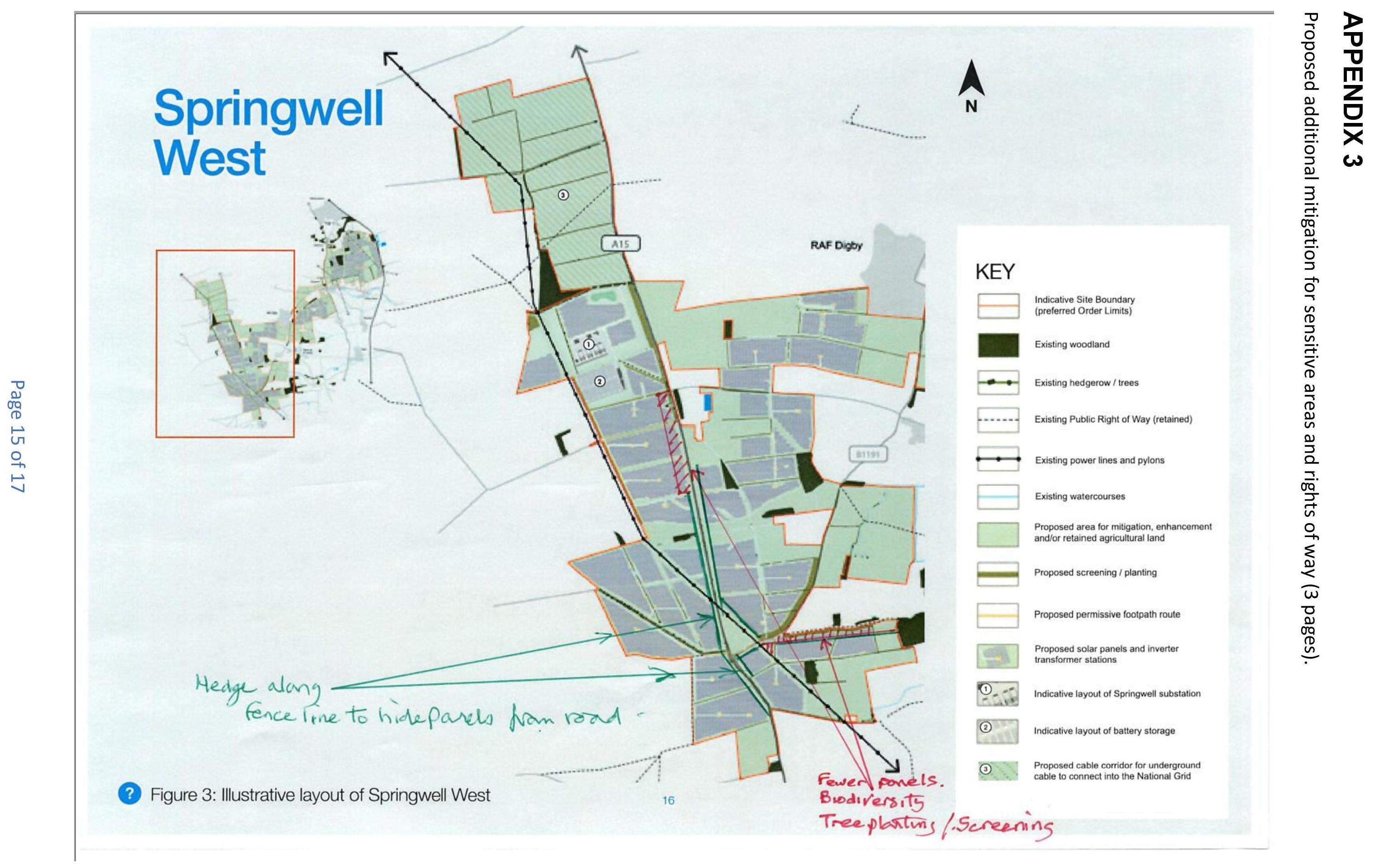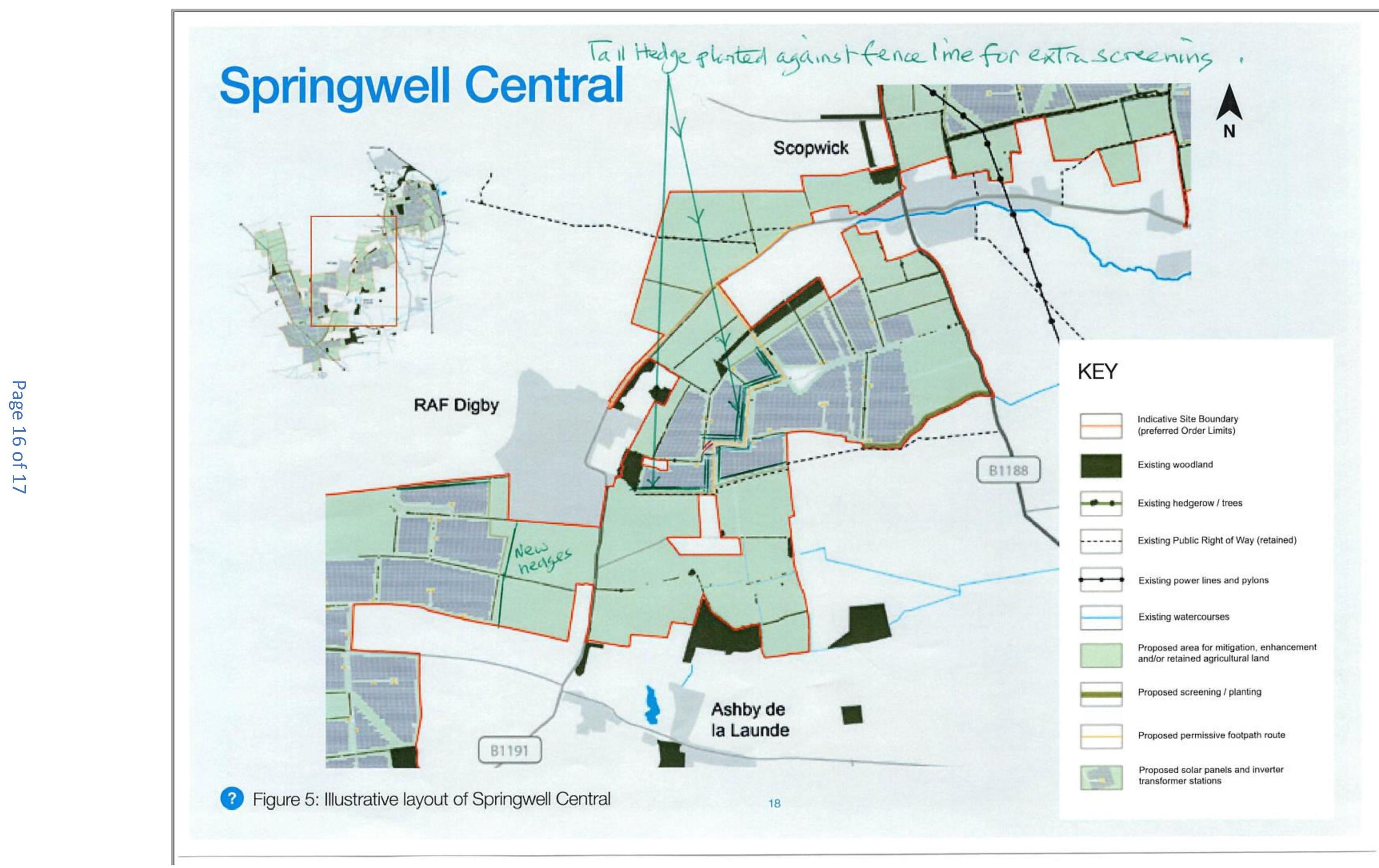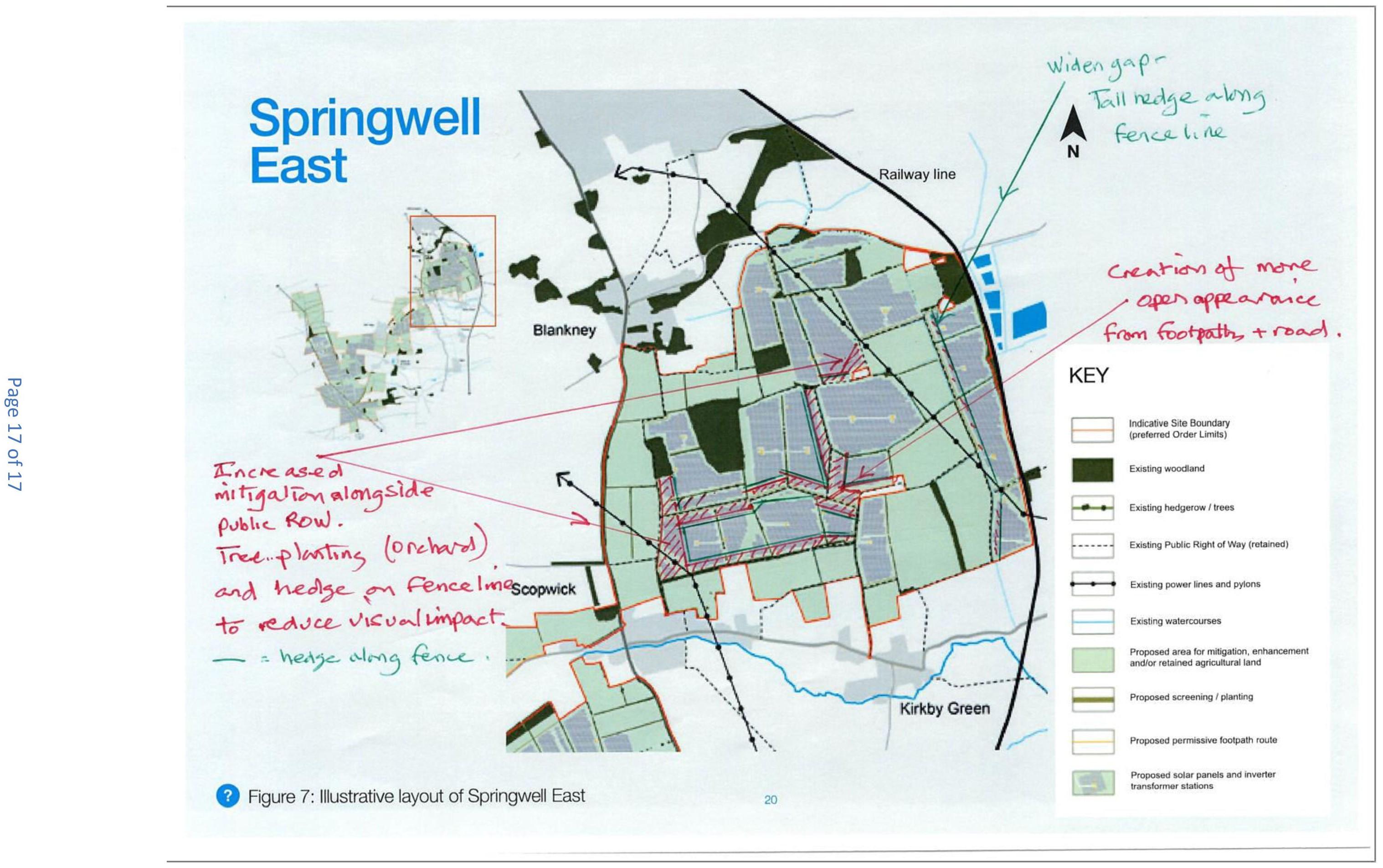Feb 2024 - Response to phase two Springwell consultation from Parish Council
16 February 2024
Scopwick & Kirkby Green Parish Council
Response to Developer on Springwell Solar Farm February 2024
It is our view that the planned development should not go ahead. We believe the proposals are detrimental to individuals, the community, health and well-being, agricultural production, the environment and eco systems.
The Springwell Solar Farm proposed development is an extremely large industrial development that will impact this rural and tranquil location for several generations. The impact of the solar panels, the associated BESS, Inverters, Substations and compounds, even with the mitigations suggested, do little to ameliorate long-term land industrialisation for future generations.
Our Parish Council has garnered the feedback (Parish Council Meeting & Parish Meeting in 2023 and subsequent discussions) from the local residents and have liaised with other impacted Parishes and the clear overwhelming response has been undoubtedly against this development. Whilst the PC acknowledges the need for the UK to become self sufficient in Energy generation it should not be at the expense of Food security and the well-being of our communities.
It is also important not to be blinded by the Net Zero narrative. EDF can’t purport to be creating a green solution if as suspected they are importing Solar Panels and Battery Technology development from China which has clearly been shown to use the most polluting industrial processes and concerning welfare conditions.
The PC is not convinced by the original or updated Springwell proposal; we question the suggested efficiency of this proposed solar farm and the proportionate loss of high yield agricultural land. EDF acknowledge that a huge proportion of this development will require the destruction of fantastic agricultural land that will take approx. 100 years to potentially return to farmland. Most likely it will be turned into industrial land in the future due to the costs to regenerate the soil and drainage.
The PC also welcomes the comments of Dr Caroline Johnson MP who is also opposed to this proposed development. The Preliminary Environmental Information Reports offer very little granular concrete answers. In many areas the responses are evasive, this is also the feedback provided by many residents who attended the local consultation events. An example of this is the often quoted line used by the EDF representatives at the consultation events that people can’t even see the Solar Panels at Branston. The representatives should be clear that the site at Branston is 160 acres and the maximum height of the panels is 2m. as quoted by Stuart Homewood, from Inazin. Branston is less than 5% the size of the Springwell proposal
We continue to suggest that EDF, Luminous Energy has preferred not to consider ALL suitable alternatives. The developer has taken the route of least resistance by selecting a single land owner in the case of Blankney Estates. We request the EA & Planning Inspectorate robustly challenges the applicant on its continued position and preferences as to the Springwell site AND the reasons it has discounted any alternative solutions. It is quite clear from the Springwell documentation NPS EN-1 paragraph 4.4.1 they have not considered alternatives and have done nothing to illustrate that this development represents the best option.
PRIME AGRICULTURAL LAND
1. Prime agricultural land should not be used for solar development
2. Lincolnshire is one of the top areas for agriculture having some of the best arable land in the country. This should not be sacrificed for power generation when there are alternatives in other sites from brownfield and industrial to roof tops and new builds. Lincolnshire also has many disused airfields and military facilities that could be developed without taking prime agricultural land.
3. Alternative locations Springwell considered for its proposal are only around the national grid connection point. There is the whole rest of the country and offshore locations that should be considered.
4. Lincolnshire farmland is rich and diverse and should not be lost to industrial energy production.
5. Prime farming land is graded, and maps exist of current gradings showing the proposed land is of high grade (2 and 3). Even the lower grades of land in Lincolnshire are higher than those in many other parts of the country.
6. The scale of this and other proposals in Lincolnshire is vast at somewhere in the region of 13,000 acres. As a country we simply cannot afford to lose this scale of productive land to industrial purposes.
7. Land is being taken out of cultivation at a rate of almost 100,000 acres per annum. At the same time yields are declining as is land quality due to the effect of global warming. So, production potential is already diminished and we cannot afford to lose further parcels of arable land to development that has no need to be there.
8. 44.3% of the area of proposed solar development in this Springwell proposal is classified as “Best Most Versatile land” It is against all good sense to use this land for solar when lower grade sites exist elsewhere in the country and where using alternative power generation methods like offshore wind are favourable. The site is 1971.45 hectares (4,872 acres), sufficient to sustain 10,000 tonnes of cereals and approximately 10,000 tonnes of other crops such as rape, peas, beans, beet, potatoes, and also grassland to support two to three thousand sheep, and woodland in integrated support of biodiversity ambitions.
9. This key reason is being cited by parishioners as a significant reason for objection, by North Kesteven District Council as their main reason for opposition, by Lincolnshire County Council as their main reason for opposition, by our local MP Dr Caroline Johnson as her main reason for opposition and by the Prime Minister Rishi Sunak as his main reason for opposition. Given this overwhelming rejection by all concerned at both local, regional and national level the project should be withdrawn.
OFF SHORE WIND POWER AS AN ALTERNATIVE
1. Off-shore wind power is a more efficient than solar and should be used instead
2. Wind is a more efficient power source than solar. Compared to solar panels, wind turbines release less CO2 to the atmosphere, consume less energy, and produce more energy overall.
3. one wind turbine can generate the same amount of electricity per kWh as about 48,000 solar panels meaning that a few extra turbines in the North Sea would secure 4200 acres locally for continued farming but extrapolated across the country probably over 20,000 acres of planned solar factories.
4. Stronger wind: Offshore wind speeds are typically higher than onshore, leading to a higher potential for energy generation.
5. Reduced visual impact: Offshore wind farms are typically located further from shore and are not visible from land, reducing visual impact.
6. In terms of efficiency rating i.e. the amount of power exported to the grid, solar’s rating is
between 11 and 15% whereas for off-shore wind the figure is 50%+
BATTERY ENERGY STORAGE SYSTEMS (BESS)
The lithium ion technology proposed has inherent stability issues as evidenced by explosions both overseas and in the UK. We are told the BESS facility will be remotely monitored.
We are still to be convinced that the size of the BESS at scale (which we understand is to be the largest in the UK) and that the associated risks are low as the applicant claims.
Other solar proposals have identified potential for fire risk from the proposed battery storage elements of their projects. What assurance can Springwell provide that no fires will happen because of this proposed project?
We would request the EA brings our continued concerns, along with other expert opinions, to the attention of the applicant.
The picture shown on plate 2.9 in SPRI-01 shows an example battery storage facility. This example has less than 20 batteries (BESS containers). The proposal is for 1,150 containers. The picture is not representative of the visual impact of this proposed size of battery facility which is over 50 times bigger.
HEALTH CONCERNS
1. We have concerns that our and others mental health would be adversely affected resulting from a loss of connection with the natural world and the disruption and stress caused by the installation of a massive industrial project around our homes.
2. Safety concerns both in terms of the instability of the lithium batteries and the increase in exposure to electromagnetic fields and high frequency radiation resulting from the operation of such a massive installation in close proximity to residential properties.
3. Removal of sewerage from construction sites is a concern. Welfare facilities to cater for up to 400 staff per site are expected. The local sewerage system is already under severe pressure and will be unable to deal with this level of increase. What are the plans to deal with this?
4. SPRI-01 pages 16 and 17 seems to be saying that contamination of soil, damage to field drains, effects on water quality in the aquifer, compaction and deterioration of soils and agricultural land, groundwater contamination due to leaks of battery system all are “Likely” but then says they are “not significant” This does not appear to make any sense, any reasonable person would think these are significant. This should be further investigated and not simply out scoped.
5. Appendix 1 is a paper written by a respected village elder and describes the detrimental effects in a heartfelt way. The effect on human life should not be underestimated nor ignored.
POLLUTION
1. Solar farms cause light pollution, which can disrupt ecosystems and wildlife. The bright lights used to illuminate the panels can interfere with the natural darkness of the night sky, affecting nocturnal wildlife and impacting the visibility of stars. Additionally, these lights can cause sleep disturbance and increase feelings of stress and anxiety in nearby residents.
2. Construction work causes noise and air pollution which is likely to be threatening to health.
3. Peace and quiet is destroyed by industrial grade traffic and light pollution.
4. Inverters can overheat in extremely hot weather requiring the use of noisy fans to provide cooling.
CLIMATE CHANGE
We note the applicant’s commentary and views on Net Zero and everyone doing their bit to help mitigate the impacts of Climate Change. Whilst there may be differing opinions on the degree to the impacts of Climate Change the PC is fully aware of its responsibilities to promote environmental initiatives as highlighted in our Neighbourhood Plan. We welcome any initiatives to provide solar panels to residential and industrial buildings and are fully supportive of the campaign run from CPRE to promote a solar roof top revolution without the need to damage agricultural land.
Page 12 of SPRI-01 states there will be greenhouse gas emission savings during operation. How is this calculated? It seems very disingenuous when you take into account all the construction work, the shipping of panels, and also the manufacturing of the panels and associated materials.
CONSTRUCTION PHASE
The applicant’s commentary remains evasive. There is no clear definitive plan to enable the PC or local residents to understand exactly what is proposed at each and every location. What is very clear is the impact on the community will be significant in the short and long term.
Over the 48 month construction phase there will be a significant increase in traffic on a rural network which already bears the scars of too many HGV movements. The increase in traffic will be in the range of 7-10% on a daily basis. We don’t see any clearly laid out mitigation plans or penalties proposed for breaches of vehicle movements
During the construction phase the local countryside will be devastated and the impact on biodiversity will be significant. The impact on the community will also be significant with constant noise especially from the piling of the Solar Panel mounts. This work will also have a major impact on existing land drainage and we foresee a significant increase in flood risk within the Scopwick & Kirkby Green Parish. What guarantees/insurance policies will EDF hold to ensure any Scopwick & Kirkby Green properties that are flooded over the 40 year life of the scheme will be made good?
Will there be construction camp living accommodation on-site? We note the hours of work. If this proposal was to be permitted, the PC would request that the construction and decommissioning phase working hours be restricted to Mon- Friday 8am -5pm with a cast iron guarantee that no work would be cared out in the evenings under floodlights.
The indication of a substantial compound on the B1188 as you leave Scopwick is a new development and has raised various concerns. The location of this site is adjacent to a listed development. The developer should be looking to locate all construction compounds well away from any residential developments due to the ongoing disruption during the construction, maintenance and decommissioning phases.
The PC as already highlighted above has major concerns with the increased volume of traffic on a rural road network which is already stressed by the number of HGV movements on a daily basis.
1. Increased traffic during construction and operational phases.
2. Scopwick has dangerous road junctions with a high occurrence of accidents and incident. The huge volume of additional traffic that will arise from construction of the solar development would cause significantly heightened road danger with a risk to life.
3. Increased volume of heavy traffic would cause damage to road surfaces like potholes and road edge cracking which would increase vehicle damage and the risk of accident and injury.
4. Up to 80 additional HGV movements per day for 4 years are estimated, this will increase the likelihood of accident and risk of death in addition to decimating the road surfaces and causing traffic delays.
5. Up to 880 additional vehicle movements per day for 4 years are expected through Scopwick. Assuming 07:00 to 19:00 this is in excess of one additional vehicle every minute and is a 41% increase in traffic based on Springwell’s own baseline data (Table 12.8 of SPRI-01). Despite this and previous points the Springwell documentation describes the impact on the B1191 through Scopwick as not significant which we strongly disagree with.
6. Page 28 of the phase two consultation booklet shows a satellite construction compound just to the south of Scopwick. There is no blue line connecting to the site. Can assurance be given that traffic will not go through the village of Scopwick to reach this site.
7. Roads, bridges, and utilities would all be adversely impacted by the extended construction work causing additional cost and risk of accident to residents and those travelling through the area.
8. 12.5.25 on SPRI-01 is incorrect page 459 / 440. The speed limit through Blankney is 30 mph not 40 mph as stated.
9. Where is the Construction Environmental Management Plan? When will it be available?
SCOPING OUT OF PARAMETERS
Due to the significant size of the Project, which covers approx. 4200 acres of good quality agricultural land and will impact multiple communities and visitors for many years, it is important that the Environment Statements (ES) are as detailed as possible and, as such, no parameter should be scoped out.
However, should a parameter be scoped out, then a detailed justification should be given as to the rationale behind the decision. Several of the proposed scoped-out parameters in the PEIR are excluded based on assumptions that some will happen or are unlikely to happen or unlikely to have an effect. These assumptions should have to be proven and should also be subject to independent validation. There are questions as to the independence of those conduction much of the assessments on this project.
LANDSCAPE AND VISUAL RESOURCES
Residential Visual Amenity Assessment should be included within the PEIR. In addition to the residential properties in the area whose visual amenity will be affected by the Project, the local countryside is enjoyed by walkers, horse riders, cyclists and all of these groups will see a significant impact on their ability to enjoy the current unspoilt countryside. The Residential Visual Amenity Assessments should be carried out as these assessments may show that the impact on visual amenity is so great that the proposed development is against the public interest.
The PC again highlights the proposed magnitude of this development and refers again to the often- misquoted Branston development. The developer needs to be honest with all members of the community about the sheer size of the overall development, be clear on the actual size of the panels, the overall number of panels, the size and number of BESS. The developer could mitigate the impact of the BESS by having these below ground level.
Due to numerous other proposed Solar developments in the area, the ES should also consider the cumulative visual impact of these additional developments when assessing the visual impact of the Project.
1. The local aesthetics will be spoilt with the sheer size and scale of the proposed development.
2. The latest literature does not seem to specify the size of the proposed solar farm in Megawatts although this is thought to be around 800 Mw. How many MW is the revised proposal expected to produce?
3. Large solar farms are visually intrusive and have a negative impact on the surrounding landscape.
4. The area has many lovely views from the villages and from public access points and footpaths around them. These views will be spoilt by large solar structures, some up to 12 metres high according to Springwell literature.
5. Continuous rows of glass panels completely alter landscape character.
6. Boundaries are changed by security fencing and the intrusion of CCTV.
7. There are many footpaths and bridleways through the local countryside, it will not be possible to go for a cycle ride or a walk from Scopwick to any of its surrounding villages or beauty spots without travelling through vast areas of solar development. This will significantly reduce views of the countryside and reduce our enjoyment of the area and spoil our precious leisure time.
8. Historic structures act as a focal point in countryside views and make a huge contribution to environmental quality.
9. The Spires and Steeples long distance footpath passes through the village of Scopwick. The aesthetics of the significant national footpath would be spoilt should the proposed development go ahead. Indeed, the views of the spires and steeples themselves would be adversely affected by the solar constructions.
10. Why is Branston commonly referenced as an example to the local community when the height of the panels at Branston are 2m vs a stated height at Springwell of 3m - 4m. This is clearly misinformation.
11. The developer proposes planting to mitigate the destruction of views. With panels a minimum of 3m up to 4m, other structures 6m-12m high the Parish Council would want to understand any planting scheme as we would insist that mature hedgerows & trees are planted as it appears very likely that the community would still have views of the site for at least a quarter of the life of the development
12. Many nature watchers use the surrounding areas for observing wildlife. These observations will be adversely affected by the proposed solar constructions. Nature will not be able to be observed in its natural habitat.
13. Collector compounds up to 6 metres high are mentioned a number of times in the phase two consultation booklet which states there would be one in each of West, Central and East. The provided maps do not show the Central and East locations. Where precisely are they planned to be situated and what will the effect on the views be then?
14. Unlike other hardware there does not appear to be pictures of the proposed 6m high collector compound infrastructure. These need to be included.
15. The visualisations in the presentation pack do not seem to show the collector compounds. These should be added to ensure a representative view is shown.
16. The picture shown on plate 2.9 in SPRI-01 shows an example battery storage facility. This example has less than 20 batteries (BESS containers). The proposal is for 1,150 containers. The picture is not representative of the visual impact of this proposed size of battery facility which is over 50 times bigger.
17. SPRI-01 page 73 talks of “Existing ProW and proposed permissive paths” being retained but does not clarify the position on existing permissive paths. Can assurance be given that these will be retained?
ENVIRONMENT, ECOLOGY AND NATURE CONSERVATION
The PEIR lists various surveys that have commenced and identify populations of fauna and flora in the area. The PC has concern that there will be a significant impact on the biodiversity of the area particularly due to the size of the area covered by the Project and the fencing in of multiple areas.
The restriction of movement for wild animals is a major concern for the community. Much more work needs to be done in assessing the impact on the fauna and clearly outlining how EDF will implement a zero-harm plan to ensure the well-being of the habitats of fauna. The impact on fauna is a paramount concern and the PC wants to see a clear plan included in any ES assessments.
1. The environment and nature including wildlife and ecosystems will be adversely affected
2. The solar panels are typically surrounded by chain link type 5ft high fences. These entrap all wildlife within the solar development as well as locking out all other wildlife outside their existing habitat. Why are wooden post and wire mesh fences needed at all? This seems as if it will stop the free roaming of deer through current natural hedges. When questioning this at the consultation we were told its mainly to keep people out. Farmland is not trodden all over and it is not fenced, people stick to public rights of way. The aesthetics would be improved if the fences were removed.
3. The Lincolnshire Heath with its unique geology and natural limestone aquifer means that it is particularly vulnerable to industrial contamination. There is a resultant risk to pollution entering the river systems and affecting not only the health of the rivers but the drinking water of the residents. Both the panels themselves and the lithium batteries used for storage have been shown to be potential contaminants.
4. The EIA Scoping report is suggesting a number of areas be in scope for further assessment. Why has Springwell chosen to de-scope these. Why not include them to give a full picture? The rationale provided states that they will not be affected so let's prove that with the assessment. Section 6.2 of SPRI-01 page 144 / 125 relates.
5. Transitory animals have their traditional routes blocked. Deer are often diverted onto roads.
6. Bird and bat deaths are common as they mistake the glass for water
7. The land is degraded with little potential for biodiversity as half of it will be in permanent shadow and rainwater run-off creates set channels without proper dispersal.
8. Where is the Environmental Statement? When will it be available?
NOISE AND VIBRATION
The developer talks about mitigating against Noise & Vibration. How will this be done in practice? As highlighted the sheer size of this proposed development means the community will have to endure piling for several years. This could have a significant impact on people’s mental well-being. Special consideration should be taking into account around RAF Digby, Oil Transport Line & Heath Farm – Autism Care (UK)
In addition to the noise & Vibration the PC want to understand the impact piling will have on the fragile clay drains which maintain the drainage across significant parts of the Blankney Estate. If
these clay drains are damaged along with the considerable damage done to the soil the expectation is there will be a significant increase in flood risk.
SOCIO-ECONOMICS
Whilst there will be limited increase to the local economy during construction and decommissioning the PC feel the impact is most likely to be negative as many hundreds of thousands of solar panels, BESS etc will limit the ability of the area to attract visitors. Whilst it is not a material factor in planning the PC is very concerned about the potential impact this development could have on local properties. Any substantive impact on house prices could leave many local property owners in negative equity. Will EDF propose any plan to ensure where this development clearly negatively affects the value of someone’s home they will compensate accordingly?
Economic Issues
1. Property values in the area would be negatively affected making it difficult to sell properties in the vicinity and effectively trapping residents in this now spoilt and undesirable area of the country. Studies have shown that property values typically decrease by between 3% and 8% in areas of solar development.
2. What are the economic benefits for the local community from the solar farm? When this question was asked at the consultation, we were informed it is a national benefit of receiving electricity not a local benefit yet it is at local level that all the disadvantages are experienced.
PROPOSED MITIGATIONS
1. Springwell documentation and representatives talk of mitigation for the impact of solar by identifying certain fields that would not be used for development. When questioned on specific plans for the identified land we were informed that it may simply stay with the landowner. If this was the case Springwell would not actually provide any mitigation with that parcel of land.
2. 42% of the site is currently described as for mitigation.
3. What specifically would those developments include?
4. Will this 48% ratio be maintained?
5. Figure 6 on page 19 shows an illustration of mitigation planned for fields on heath road. Which fields does this relate to? From the figure 5 diagram it is difficult to see which fields fit the visualisation.
6. Page 18 of the booklet shows a new permissive path, page 19 talks of this being a loop. It is not clear from the diagram where the loop is, could this be pointed out please
7. Page 28 shows a “main construction compound” just to the north of Scopwick. This same area is shown on figure 7 as a proposed area for mitigation and enhancement. It seems unlikely it can be both. If it is planned to be mitigated and enhanced when the construction site is no longer needed when is that planned to be? 4 years?
8. Page 21 of the booklet describes how no panels will be placed between the spires and steeples trail and the B1188 to improve the aesthetics. This whole area however is shown on page 28 as a main construction site with facilities for up to 400 staff which is unlikely to improve the aesthetics at all in fact it will make it significantly worse.
9. Screening the view to solar infrastructure is mentioned in the booklet as being a key mitigation. The governments EN3 document states “screening along public right-of-way networks to minimise the outlook into the Solar Park may, impact on the ability of users to appreciate the surrounding landscapes” This looks like it will be the case in this proposal. What is being done to deal with this concern?
10. SPRI-01 identifies many changes to views and landscape character on page 14. It will not be possible to walk from Scopwick to surrounding villages without the view and landscape character being significantly changed for the worse by this proposed development.
11. The Parish Council, listening to our community feel this site is far too large. We have illustrated on the various attached maps (Appendix 2 & 3) where we propose the plan can be enhanced to more adequately suit this tranquil environment.
12. Maturity of mitigation. To ensure 3 m and 4 m solar panels, 6m collector compounds and battery storage areas are screened with mature hedges and trees sufficient in size to screen the infrastructure immediately.
CUMULATIVE EFFECTS AND INTER-RELATIONSHIPS
To be able to visualise the cumulative impact of developments in the area, Scopwick & Kirkby Green PC would like to request that the EDF include a plan that shows the Project in relation to not only all the approved and proposed residential developments in the area, but also to the approved and proposed solar farms and other non-residential developments in the area, such as, for example, the Anaerobic Digester at Martin, National Grid at Navenby, Fosse Green Solar, Heckington Fen Solar Park In addition to these proposed developments, the plan should also include developments built/being built but not yet showing on the OS base map being used. They should also show the built solar farms already in the area as, unlike residential developments, the OS base map does not show these types of developments and it could be assumed that these areas are undeveloped and still open countryside.
NEIGHBOURHOOD PLAN
The Parish approved the Neighbourhood Plan by a substantial margin in the summer of 2021 and the Plan has been adopted by NKDC. Part of the plan addressed future developments within the Par- ish. This is highlighted at;
- Page 9 table 1 Extract from Summary of Household Questionnaire 2019 point 13
Respondents were concerned about development impacting on significant views and development not fitting in with the surroundings.
- Page 15 under Community Objective 8.
To ensure that future development minimises its impact on the environment by;
a) using energy efficient materials.
b) a layout that benefits from passive solar gain and
c) encouraging small scale renewable energy.
The Scopwick and Kirkby Green residents have made it quite clear that there is no support for large industrial developments within in Parish.
CONCLUSION
In conclusion the PC are of the view that this proposed development is the industrialisation of an agricultural rural area. We see projections quoted in the literature regarding the number of houses this development will power, having reviewed many documents it is clear that these numbers are based on best case guesses and aspirations and should be taken with a large amount of cynicism
The Springwell document sets out four thematic principles to shape the design of NSIPs. These are:
• Climate - Mitigate greenhouse gas emissions and adapt to climate change.
• People - Reflect what society wants and share benefits widely.
• Places - Provide a sense of identity and improve our environment.
• Value - Achieve multiple benefits and solve problems well.
As a Parish Council it is not clear how this development meets any of these 4 thematic principles.
It is also very clear from the documentation that the Communities most impacted by this development will receive very little in way of mitigation. To be clear the community is not in favour of this development based on its size and impact on this rural community. However, if this development was to be granted permission by the Inspectorate, Scopwick & Kirkby Green Parish would expect the following incentives to be delivered within 12 months of the scheme being granted permission
1. All properties within the boundaries of the development to receive 60% reduction on their electricity bills for the operational life of Springwell
2. All properties within the boundaries of the development to be offered free solar installation including battery storage
3. A Birmingham University study “The Disamenity Impact of Solar Farms: A Hedonic Analysis - 2022” concluded that property devaluation is likely to be in the region of 5.4%. A compensation plan for devaluation of land and property should be put in place.
The request above would be over and above any proposed benefit under the Springwell Community Benefit Fund. The Parish Council would like to understand the mechanism for how this fund is managed and by who. The impact of this development impacts a number of local communities and the funds should be administered by these communities for the good of these communities. It should not be part of a mechanism to support schemes across the wider Lincolnshire County. The figure of £400 per megawatt per year is derisory when put in context to the profits that will be generate by EDF and the Land Owner. The minimum contribution to the Community Benefit Fun should be £1000 per megawatt per year and this fund must be administered locally and spent directly within the impacted parishes.
EDF should also provide a comprehensive package for the wider community to mitigate the stress and ongoing impact of this development. This should cover themes such as:
• Mature planting scheme
• Building Footpaths
• Improvements to drainage
• Contributions to enhance local roads
• Cycle routes
• Improve and extend Swimming pool at Metheringham and install solar heating
• Provide additional sports facilities i.e. All weather tennis court
APPENDIX 1
Paper written by John Woodward, a village resident, which was submitted to us in January 2024
Giving up agricultural land for green energy profits
In the proposal by Springwell Solar 4300 acres of agricultural land is to be lost to create an industrial scale development consisting of a sea of solar panels surrounding Scopwick village and extending to areas beyond. Aside from the resulting loss of land needed to grow food there is another compelling argument against such a development.
Everyone values our countryside for its natural qualities from which all of us in some way benefit when we come in contact with it. This important fact is now being taken on board by the medical profession and through them by government itself who see this as a way to improving and maintaining the health and well-being of the nation without the need for (costly) medical intervention.
The proposed “solar megafactory”, for that is what in effect it will be, will deny those living in the rural areas surrounding Scopwick and the many from all over who go there by choice to enjoy the benefits of walking, cycling and riding, as also the good company of others, which nature makes abundantly available on the extensive and varied tracks, bridleways and footpaths which the area’s principal landowner in the tradition of a true benevolent landlord had assiduously and uniquely built up over the years for use by the general public as well as for its own farming activities.
In exchange the solar development is claiming to contribute enormous quantities of the sun’s free energy to the national grid and thereafter to restore the land to farming use after a period of 50 years. It should be said that neither of these claims are capable of being verified as with these large-scale solar farms there are not only many as yet untested potential dangers and drawbacks to be faced but also as yet no experience on which to postulate results with any certainty. Nor will the vague suggestion of compensation being offered to the local population by the developers in any way match the loss of what Nature currently is able unfailingly freely to provide for their life and wellbeing and not to mention useful employment for many.
There are other ways some known and others yet to be discovered whereby the green energy the nation requires can be made available – and not forgetting ways that save on energy use - and it is wide open and fitting that those with opportunities to invest their resources on a large scale should do so in ways that work in harmony with nature to procure profit for themselves while benefitting society as a whole instead of mindlessly laying waste our precious rural resource.
